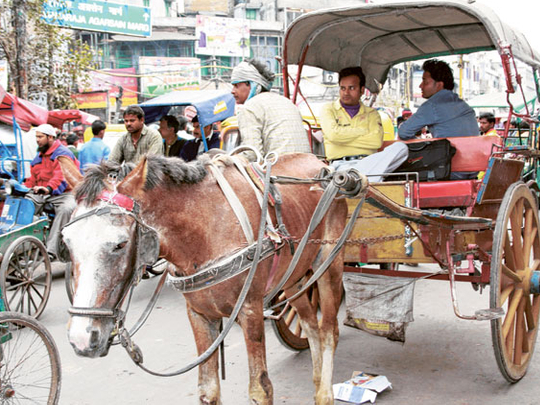
History finds a place in every nook and corner of Delhi but the tonga (horse cart), which symbolised tradition on the roads, is fading into oblivion. The few that remain are now plying only in certain parts of Old Delhi, which include Sadar Bazaar, Paharganj and Nandnagri.
The Municipal Corporation of Delhi (MCD) took the decision to put a halt to tongas last year, citing traffic congestion on busy roads as the reason.
Unfortunately, unlike Mumbai and Kolkata, which have kept the buggies for tourist rides, the residents of Delhi will see no such luck due to the policies of its government.
While the Victoria tongas ply on Marine Drive and around Gateway of India in Mumbai and offer sheer pleasure to tourists, in Kolkata they are a gentle and thrilling reminder of the days of the British Raj.
Chris Lee, a tourist from Denmark, said: "I was in Mumbai and the tonga ride there was an out-of-the-world experience. Sitting in the carriage, I felt like a maharaja. But I'm surprised that New Delhi, with several spectacular buildings and historical forts, has not taken any such initiative. I was sad to see the pathetic condition of the tongas in the capital. I had longed to view some majestic buildings at a slow pace rather than whiz past them in a car."
But the MCD will have none of it. "Tongas are ruled out in the main city, though we are deliberating upon the idea of letting them operate in theme parks for short joy rides. But nothing has been finalised yet," a senior official said.
Imploring tonga owners to treat their horses with dignity, he said: "They make the animals work at a stretch for long hours in extreme conditions without proper food. This should stop."
In a city jammed with cars, autos, buses and now metro lines, this humble mode of transport has taken a beating from all sides. About three decades ago, there were 3,500 tongas that clip-clopped in the streets. Today the number has fallen to less than 100.
No doubt, in this age of fast cars, the tolerance level for tongas is dipping and to streamline the capital's transportation, the MCD has had to take viable decisions.
However, the tonga owners are a dejected lot. Chandni Chowk resident Shahab Al Deen reminiscences: "Our ancestors have been doing this job from the time of the Mogul emperor Shah Jahan.
And from generation to generation this has been the basis of our livelihood. We don't mind being given other routes to ply on. If the government wants, it can give us embellished tongas, for which we are ready to take loans. But killing our source of income is injustice. It is difficult to adapt to a new profession, as most owners are past their prime."
"Plying the tonga 10 to 15 years ago fetched me good money. But ever since areas such as Connaught Place, Chandni Chowk and South Delhi have been closed to us, my earnings have dwindled," he adds.
Even then the owners did not see the writing on the wall. Shahab Al Deen counters: "How could we? In our family, men knew no other skill. For some time it was hand-to mouth living for us. But one can't live on hope and now people have started taking up sundry jobs."
Yamin says: "I woke up one morning to find my horse missing. The police had come with some MCD officials and confiscated our horses. I was told to pay a penalty of Rs2,000 (Dh167) and an additional Rs500 for feeding the horse. I had to pay the huge amount, though I know they did not feed the horse and pocketed the money."
Yamin has given the tonga to his brother, who lives in Sadar Bazaar, where the ban doesn't apply. Left with no alternative employment, he now cleans trucks, which fetches him Rs100 to Rs150 a day. "Earlier, I was able to earn at least Rs350 daily," Yamin laments.
Lal Singh suffers the same fate. He has taken to repairing scooters and has let out his tonga to be driven around Paharganj. Singh rues: "It was our own business and it pains me to do a job for others."
Ramesh Pal is equally perturbed. "The authorities say there's no demand for these slow-moving vehicles in today's age. But no one is bothered about how our families will survive. I wrote to the prime minister and Delhi's chief minister. Except getting letters from them forwarding my request to the MCD, nothing has happened. Soon, memories of the tongas will be relegated only to Hindi films," he says.
Many popular songs have been picturised on tongas. One can't forget Dilip Kumar's emotional attachment to the tonga in Naya Daur, and for Hema Malini in Sholay, the tonga was a source of livelihood.
The tonga may not be in sync with modern life but Delhiites have fond memories of it. Says a nostalgic Meena Agrawal: "We used to go to school in a tonga. And I still prefer it to a motorised vehicle."
Nilima Pathak is a journalist based in New Delhi.












